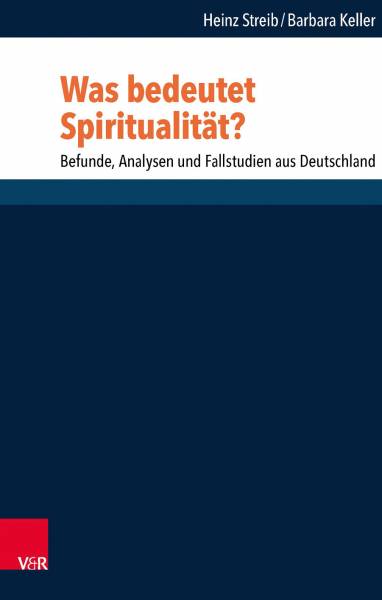Spiritualität

Spiritualität in Deutschland und den USA
Das Projekt wurde gefördert aus Drittmitteln der Deutschen Forschungsgemeinschaft (DFG) und der John Templeton Foundation.
Leitfragen
„Spirituell“ zu sein hat in den vergangenen 30 Jahren erheblich an Popularität gewonnen. Viele Menschen in den USA sagen von sich, sie seien „mehr spirituell als religiös“, in einer Umfrage aus 2018 sind es 20%, die sich als „spirituell, aber nicht religiös“ bezeichnen. In vielen europäischen Ländern sehen wir ähnliche Muster, jedoch mit deutlichen regionalen Unterschieden: zwischen 10% in Deutschland-Ost, 15% in Deutschland-West bis zu 24% in Finnland und Slowenien. Während solche Umfrageergebnisse die Häufigkeiten der Selbsteinschätzung als religiös, spirituell oder säkular berichten, liefern sie jedoch wenig Informationen über die Semantik, über die funktionalen und psychologischen Merkmale, und die biographischen Kontexte dieser Orientierungen. Unsere Forschungsergebnisse bieten Einblicke und Erkenntnisse zu einigen Fragen.
Methode
Das Ziel unserer ersten Spiritualitätsstudie (2009-2012; Ergebnisse sind veröffentlich in: Streib & Hood, 2016) war die Erforschung der Semantik und Psychologie von Spiritualität. Grundlage waren Fragebogen-Antworten in Deutschland (n=773) und den USA (n=1.113) sowie n=108 persönliche Interviews—Faith Development Interviews, die eine Analyse von religiösen Stilen sowie von biographischen Kontexten der Selbstbezeichnung als „spirituell“ ermöglichen. Eine der Besonderheiten ist unser Forschungsdesign, das Antworten zu einem Fragebogen und Transkripte von Interviews miteinander vergleicht (trianguliert).
Der Fragebogen enthielt unter anderem: (a) Fragen, wie sehr sich die Person als „religiös“, „spirituell“, oder „atheistisch“ bezeichnet, (b) die Frage, wie sehr sie sich als „mehr religiös als spirituell“, „mehr spirituell als religiös“, „beides“ oder „weder-noch“ bezeichnet, (c) semantische Differentiale (Osgood; kontextuell), und schließlich (d) die Einladung and die Teilnehmenden, ihre eigenen Definitionen von „Religion“ und „Spiritualität“ in ein Textfeld in unserem Fragebogen einzutragen. N=1.039 Personen in den USA und n=727 in Deutschland sind dieser Einladung gefolgt. Diese Daten eröffnen eine neue Perspektive auf die Semantik von „Spiritualität“.
Nach dieser ersten Studie über Spiritualität haben wir unsere Forschung in einem Längsschnitt fortgeführt und eine zweite und dritte Erhebungswelle mit jeweils ca. 3 Jahren Abstand hinzugefügt. Der Fragebogen wurde mit kleineren Veränderungen weitergeführt und, das ist sehr bedeutsam, enthielt weiterhin die Frage nach der religiös/spirituellen Selbsteinschätzung sowie die freien Eintragungen der Definitionen von „Religion“ und „Spiritualität“. Auch die Einladung zu einem persönlichen Interview wurde weitergeführt. Freilich haben nicht alle an den Fortsetzungserhebungen teilgenommen, aber viele nahmen mehrfach an der Umfrage und am persönlichen Interview teil. Dies konstituiert unser Längsschnitt-Sample, das Perspektiven auf mögliche Veränderungen in der Semantik von Spiritualität, deren Ursachen und Folgen, sowie auf die Beziehung zu biographischen Veränderungen eröffnet.
Ergebnisse
Wie verhält sich eine „mehr spirituell als religiöse“ Selbstbezeichnung zu Persönlichkeitszügen, mystischen Erfahrungen, und anderen individuellen Merkmalen?
- Unsere neueste Analyse (Chen et al., 2023) hat alle Fragebogendaten (n=3,491, also über die aus der Spiritualitätsstudie hinaus) untersucht und dabei u.a. gezeigt, dass Offenheit für Erfahrungen, eine der „Big Five“ Persönlichkeitsdimensionen, für die „mehr spirituell als religiösen“ Probanden deutlich höher ist. Damit bestätigt diese aktuelle Untersuchung frühere Analysen, die für die Gruppe der „mehr spirituell als religiösen“ Teilnehmenden Werte für Offenheit für Erfahrung ergeben haben, die deutlich höher sind als die Normwerte für die Bevölkerung (Streib et al., 2016).
-
In einer Längsschnittanalyse wurde in derselben Studie (Chen et al., 2023) auf der Grundlage von n=751 Personen u.a. gezeigt, dass eine “mehr spirituell als religiöse” Selbstbezeichnung zur Folge hat, dass einige Jahre später mehr mystische Erfahrungen berichtet werden und ein mystisches Gottesbild bevorzugt wird. Das bestätigt unsere früheren Analysen, die eine starke Beziehung zwischen mystischen Erfahrungen und Präferenz für „Spiritualität“ aufgezeigt haben (Streib & Chen, 2021; Streib et al., 2021; Klein et al., 2016). Diese Ergebnisse weisen darauf hin, dass Hoods (1975) Mysticism Scale ein effektives Messinstrument für „Spiritualität“ ist. Die Ergebnisse legen auch nahe, dass sich Mystizismus und Spiritualität gegenseitig verstärken – und wir von einem circulus mysticospiritualis sprechen können.
-
Zusammengefasst: Unsere Ergebnisse zur Bedeutung der Definitionen von „Spiritualität“ zeigen einerseits eine enorme Vielfalt von Bedeutungen auf, andererseits lassen sich drei Schwerpunkt-Bedeutungen erkennen: (a) ein eher ‚religiöses‘ Verständnis, das „Spiritualität“ mit Gott, Jesus, Bibel, Organisation und System assoziiert, (b) ein Verständnis von „Spiritualität“ als Verbundenheit mit anderen Menschen, mit dem inneren oder höheren Selbst, mit der Natur, mit dem Universum – was sich durchaus mit der engen Beziehung zwischen Mystizismus und Spiritualität zusammenbringen lässt, und (c) ein Verständnis, das „Spiritualität“ mit Moral und Ethik zusammenbringt, und einer Orientierung an der Menschheit als Ganzem.
Welche Bedeutung hat „Spiritualität“ in biographischer Perspektive?
- Auch die Analyse der Interviews zeigt, wie vielfältig „Spiritualität“ verstanden wird, und bestätigt das Ergebnis der genannten semantischen Analysen. Aber die biographischen Analysen zeigen mehr: „Spiritualität“ wird in unterschiedlichen Lebenszusammenhängen unterschiedlich verstanden und gelebt – und dabei ist „Spiritualität“ nicht nur auf religiöse, sondern auch für säkulare Identität bezogen. „Spiritualität“ erscheint als semantisches Angebot, das es Menschen ermöglicht, zur Sprache zu bringen, was sie bewegt, was sie erleben, was sie „unbedingt angeht“, ohne dass sie auf „Religion“ Bezug nehmen müssen.

